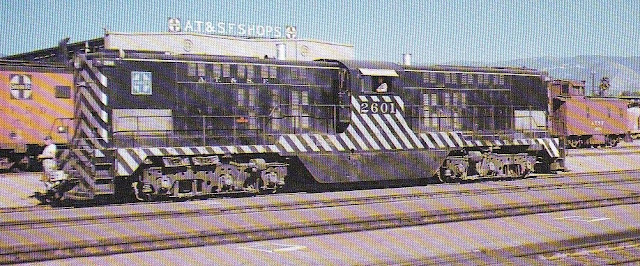Our Victorville locomotives this time are Santa Fe's Baldwin Centercab DT6-6-2000 diesels, and my layout progress report will look at more cork roadbed being laid on the staging deck.
Santa Fe bought seven of the big Baldwin centercabs from mid-1948 through early 1950, numbered 2600-2606. But only two of them are known to have worked as helpers on Cajon Pass:
#2600 from delivery in June, 1948, until sometime in 1949 or 1950, when it began pulling transfer runs to the Los Angeles harbor until 1956; and
#2601 (bought in August, 1949) starting from about mid-1950, when it pulled coal loads from San Bernardino to the Kaiser Steel plant in Fontana on weekdays and served as a helper on Cajon Pass on the weekends (according to Chard Walker).
Here's a G.M. Best photo of #2600 when new (July, 1948), in Los Angeles:
At this time the zebra stripes were limited to the frame (until 1950).Here's a rare photo from the collection of David Lustig showing #2600 in helper service at Summit, about to run light back to San Bernardino:
Since Cajon Pass helper service involved helping trains out of Victorville too, we can assume that they were also seen in Victorville, although no photos of them there have turned up.
Sometime in 1949 or 1950 #2600 finished its Cajon Pass assignment and moved to the Harbor District, along with #2602. Then #2601 showed up in San Bernardino to pull loads of coal from San Bernardino west to Fontana on weekdays, and to help trains over Cajon Pass on weekends.
Here's a color photo by Jack Whitmeyer of #2601 at San Bernardino in Jan. 1953:
Note that the zebra stripes now include the side of the cab, but not yet the lower part of the frame.
Jack whitmeyer also shot #2601 and its crew in San Bernardino in April of 1952:
And then again in July of 1952, with its caboose:
In 1956 the 2600s were transferred east. Here is our #2601 at Argentine in Nov. 1956:
As for HO models, I have one of the expensive, painted models that Division Point produced years ago, like this one:
They also made some with the later zebra stripes and the longer upper walkway:
Now let's take a look at my layout progress, which involved gluing down a lot more cork roadbed with DAP Alex Plus caulk. It's the turnout areas that take a lot of the time, as wedge-shaped pieces of cork have to be cut to fill in where the two roadbeds come together.
Here's a view of the new roadbeds leaving Section 8 and curving farther into Section 1:
Note the small Dustbuster vacuum in the left corner, which is very useful in cleaning up all the cork bits after I sand the rough edges off the cork.
This next photo shows the tangle of turnouts near the edge of Section 1, including the turnout to the future helix track at the lower left:
Now we look back at this Section 1 area from Section 2:
A week later, things are still moving along, day by day. Here's a view looking from Section 1 toward Section 2, where the roadbed for some mainline crossovers has now been laid:
Also, note that I've begun cutting and setting in some sheet cork that will support the ladder tracks that run beside the mainline, and note the ladder turnouts that are being temporarily located on the sheet cork.
Here's a closer view of this area on Section 2, with two double-slip switches also visible in the foreground:
Finally, we'll look at the advancing mainline roadbeds, as they now flow through Section 3 and curve into Section 4 in the foreground:
The black box behind the Dustbuster is my CD player, for listening to my 1950s rock & roll CDs while I work! Next week I may be able to complete the mainline cork all the way around the edges of the layout, until I meet the final tangle of turnouts on Section 7.
Meanwhile, I've been discussing ideas with Jim Coady for how to cut and build the Rainbow Bridge pieces, including maybe using a Cricut Maker cutting machine and/or a 3D printer, which my library has available for public use. Here are some recent ideas for making the bridge parts, thanks to Jim Coady:
I'll be back with more locos and more cork roadbed in a couple of weeks.















Love those center cabs. It’ll be interesting to see that bridge built.
ReplyDelete